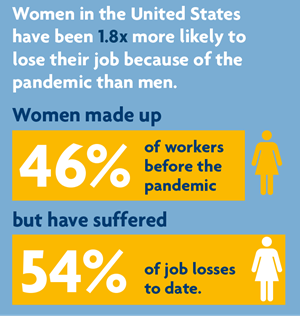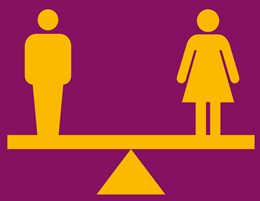NEWS
Monday 8 March 2021
Gender equality has been at the forefront of the social, political and business agenda for a number of years, with gender pay gap reporting now a legal requirement in many of the world’s leading economies.1 But we have been living through an unprecedented health and economic crisis for over a year and the concern is that the COVID-19 pandemic has not only seen the push for gender equality stall, but actually go backwards.
With International Women’s Day on 8 March 2021 – an annual campaign focused on gender equality whose significance grows each year – there’s no better time to discuss the impact the pandemic has had, and is having, on gender equality. In this Viewpoint, we’ll look at some areas for concern, suggest where employers can focus in the push for gender equality in a post-pandemic world, and see where there have some positives for women due to work / life changes. Let’s start with some of the more adverse effects.
What impact has the pandemic had on women?
 According to the UN Global Compact, women have been disproportionately affected by the pandemic. Firstly, 60% of women’s employmentis informal leaving them with few protections and the global gender pay gap is stuck at 16% leaving them more vulnerable to economic downturn. Women make up the majority of healthcare workers which has, no doubt, put them in greater danger.2 Add to this, the burden of care – whether that’s for children, elderly relatives or simply the family – that still tends to fall on them.
According to the UN Global Compact, women have been disproportionately affected by the pandemic. Firstly, 60% of women’s employmentis informal leaving them with few protections and the global gender pay gap is stuck at 16% leaving them more vulnerable to economic downturn. Women make up the majority of healthcare workers which has, no doubt, put them in greater danger.2 Add to this, the burden of care – whether that’s for children, elderly relatives or simply the family – that still tends to fall on them.
Looking in more detail at the employment angle, both men and women tend to be more represented in certain sectors, but women are over-represented in three of the four most negatively impacted ones. Global research by McKinsey & Co found that women account for 39% of the workforce but in accommodation and food services they account for 54%, retail and wholesale trade it is 43% and arts, recreation and public administration it’s 46%.3
The research also found women in the United States have been 1.8x more likely to lose their job because of the pandemic than men. Women made up 46% of workers before the pandemic but have suffered 54% of job losses to date.
 Tragically, in Japan, there’s been a large rise in suicide rates in young women in the last year, which some experts believe could be linked to the economic impacts of COVID-19.4 This, they believe, is partly due to the growing number of single women who had precarious employment status pre-pandemic and have since hit hard times with little prospect of relief.
Tragically, in Japan, there’s been a large rise in suicide rates in young women in the last year, which some experts believe could be linked to the economic impacts of COVID-19.4 This, they believe, is partly due to the growing number of single women who had precarious employment status pre-pandemic and have since hit hard times with little prospect of relief.
And it’s not just about a lack of employment opportunities or job losses, the burden of unpaid care is an important factor, too. Women are usually on the front line of care, doing an average of 75% of the world’s total unpaid care work including childcare, household chores and caring for the elderly.5 With schools shut and families at home during lockdowns, this burden will have grown significantly
In certain South Asian, Middle Eastern and North African countries, a woman’s share of unpaid care and domestic work is as high as 80- 90%, while in India, women are spending around 30% more time on family responsibilities than they were pre-pandemic.6
Both these economic and care factors are problematic and need addressing. The UK Women and Equalities Committee Report into the gendered economic impact of the pandemic found some schemes, such as the Coronavirus Job Retention Scheme (CJRS), while supporting millions, had overlooked the labour market and caring inequalities faced by women.7
There’s also mental health to consider. The pandemic has had a negative impact on women’s mental load – the stress and fatigue related to organising the home and caring for their families – with 51% rating it as “high”, which is up 10 points from pre-pandemic levels.8 Women’s mental load increased most in the countries with the highest number of COVID-19 infections, particularly Mexico and Spain, while in Nigeria, where infections are low, there was no reported increase to women’s mental load.
Has COVID-19 forced workplace gender equality to take a step back?
Women’s equality organisation LeanIn and McKinsey & Co’s 2020 Women in the Workplace report found slow but measurable progress in gender equality had been made pre-2020 but noted that many of these gains could be wiped out by the pandemic.9
There are three groups particularly adversely affected:
- working mothers, who were already working overtime and no longer have a divide between their two roles
- senior level women who are often held to higher standards and blamed more than their male counterparts
- women of colour who are more likely than other employees to feel excluded at work.
In the UK, the impact of school closures has been felt much more by mothers than fathers. A survey by organisations including the Women’s Budget Group and the Fawcett Society found 15% of mothers had to take unpaid time off compared with 8% of fathers. And it’s not just the present but the future – 43% of working women are concerned about their job or promotion prospects due to the pandemic and 35% of women have lost work or hours due to a lack of childcare. 10,11
43% of working women in the UK are concerned about their job or promotion prospects due to the pandemic…
Lockdown work imbalance between parents
The institute for Fiscal Studies and University College London conducted a study in May 2020 among 3,500 families of two opposite gendered parents and found that mothers were doing more childcareand housework than fathers.12
 Key findings:
Key findings:
- The mothers looked after children for an average of 10.3 hours a day – 2.3 hours more per day than fathers
- Mothers also did housework for 1.7 hours a day
- Mothers were 23% more likely than fathers to have temporarily or permanently lost their job or quit and 14% more likely to have been furloughed.
- Prior to the crisis, working mothers did paid work in 6.3 hours of a weekday on average. This has fallen by over one-fifth to 4.9 hours since COVID-19
- Working fathers’ hours have also fallen, but by proportionally less, from 8.6 hours before the crisis to 7.2 hours now.
COVID-19 has left millions of women worse off
AXA surveyed 8,000 women from different social backgrounds in eight countries: France, Germany, Italy, Mexico, Nigeria, Spain, Thailand and the UK to understand how COVID-19 is affecting women and how they feel about the future.13
Results suggest that COVID-19 has left millions of women worse off. Nearly half (47%) have had to dip into savings to make ends meet or turn to others for support. Among the hardest hit are younger women, women with children and those in developing countries with little or no access to benefits or financial support. Women feel more vulnerable due to COVID-19, with half (50%) feeling more exposed to financial risk.
In a survey carried out only in the UK by Finder, however, results suggested that during lockdown, a higher percentage of men had to dip into their savings — 37% compared to 34% of women — and they used more than twice as much of their savings than the average woman, at about £1,940 compared with £898.14
As an employer, how can you help?
There are steps employers can and many are already taking to support all employees and to ensure they are part of the solution, not the problem, when it comes to challenging gender inequalities.
The Harvard Business Review interviewed working mothers in the United States about whether their managers had supported them and found three ways in which employers can ensure mothers remain in the workplace:15
 Provide certainty and clarity, wherever possible – be clear about job expectations and performance standards and communicate policy changes in a timely manner, informing them on what decisions are being made and why.
Provide certainty and clarity, wherever possible – be clear about job expectations and performance standards and communicate policy changes in a timely manner, informing them on what decisions are being made and why.
 Right size job expectations – implement parent friendly scheduling policies and ensure that everyone knows it’s ok to use them. To accommodate heavily impacted employees, managers can update job descriptions, or allow employees to craft their own jobs which in turn can create developmental opportunities for those with more time.
Right size job expectations – implement parent friendly scheduling policies and ensure that everyone knows it’s ok to use them. To accommodate heavily impacted employees, managers can update job descriptions, or allow employees to craft their own jobs which in turn can create developmental opportunities for those with more time.
 Continue empathy – ask employees what they need, how they feel and if they are comfortable with how they work. A simple approach would be to start meetings by checking in on how people are doing, asking about the family and showing interest – don’t ignore the situation and pretend it isn’t happening.
Continue empathy – ask employees what they need, how they feel and if they are comfortable with how they work. A simple approach would be to start meetings by checking in on how people are doing, asking about the family and showing interest – don’t ignore the situation and pretend it isn’t happening.
Looking forward, employers who want to ensure the pandemic doesn’t have a lasting negative impact on gender equality need to think more broadly about their current and future policies and procedures.
Law firm Clyde & Co, for example, suggests that employers should review their diversity and inclusion initiatives to ensure they are relevant post-pandemic and will be effective in dealing with any issues created by COVID-19.16
They recommend employers create or maintain flexible working policies if they aim to attract and retain staff during and after the pandemic, particularly female employees. As women take on the bulk of childcare responsibilities, employers will need to be mindful of personal circumstances and ensure that the “new normal” is used to further support and enhance inclusivity.
The UK Women and Equalities Committee Report focuses on policy and legislation and one key recommendation for employers is to remove the 26-week service threshold for employees to request flexible working arrangements as, the report suggests, the pandemic has clearly demonstrated that it’s both unhelpful and unnecessary.7
“There is a danger that women are the ones who are likely to opt to work from home, and offices may just end up being the places where men go to… we worked so hard to say a woman’s place is not in the kitchen. We don’t want corona to say a woman’s place is in the home, that she’s sitting in the kitchen with her laptop and the men’s place is in the office.”
A note of caution for the future
While the widespread adoption of flexible working should create more gender equality, there is a risk that men will choose to return to life as normal and leaving women to continue working from home. If parents are given a choice of returning to workplaces or staying home, the imbalance in unpaid domestic labour may convince a disproportionate number of women to choose remote working. A sudden reduction in the number of women in workplaces could undo some of the equity progress made, so employers need to make a conscious effort to keep workplaces diverse and inclusive and ensure they do not unconsciously create a male-dominated office environment.
Phumzile Mlambo-Ngcuka, Executive Director of UN Women, said: “There is a danger that women are the ones who are likely to opt to work from home, and offices may just end up being the places where men go to… we worked so hard to say a woman’s place is not in the kitchen. We don’t want corona to say a woman’s place is in the home, that she’s sitting in the kitchen with her laptop and the men’s place is in the office.”17
Have there been positives for women?
Although women seem to have been disproportionately negatively impacted by the pandemic, there are some instances where this isn’t the case. Despite the warnings from the UN, some believe that increasingly flexible working patterns are crucial for retaining women in work. 76% of women in a 2017 survey said that remote work was necessary for companies to retain staff long-term.18 And now in 2020 and 2021, with home-working an essential part of companies’ culture, businesses are likely to be more willing to continue with these policies. Plus, employers are now more used to judging employees by outputs rather than who is most visible in the office.19
Similarly, the remote work trend means informal opportunities to get exposure – like after work drinks or staying late in the office – are not taking place, the playing field has been levelled for those who haven’t been able to take advantage of those opportunities – although this might return once the world returns to some form of normality.
Another positive has been in the area of childcare. The Institute for Fiscal Studies estimates that fathers are covering nearly double the hours of childcare than before the crisis, suggesting that attitudes about the role of fathers in providing childcare and domestic work may have changed – it may not be perfectly even but it could be improving. And, as the findings from the Fawcett Society11 indicate, equal childcare would create more workplace equality and reduce the gender pay gap, enabling women to fulfil their potential at work.
Is there room for optimism for gender equality? AXA’s study found, despite the challenging circumstances, most women are “mildly” optimistic about the next six months and expect their prospects either to improve or stay the same. Nearly half (46%) believe their job situation may improve, while similar figures believe their stress and tiredness levels will come down. Women in emerging countries feel the most positive while in Europe, women are less optimistic, particularly about future job security.
…fathers are covering nearly double the hours of childcare than before the crisis, suggesting that attitudes about their role in providing childcare and domestic work may have changed.
And this is not just important culturally, it can have a significant economic impact as well. McKinsey & Co predicts that pandemic recovery efforts that invest in the female workforce could significantly boost employment opportunities and drive inclusive economic growth. While countries like Iceland, Norway and Finland top the World Economic Forum’s Global Gender Gap Index20 ranking, gender parity is not forecast to be achieved for 100 years unless action is taken to redress gender imbalance.
If no action is taken to counter the effects of the pandemic – well, estimates suggest global GDP could be US$1 trillion lower by 2030, whereas taking action to advance gender equality could add US$13 trillion to global GDP.5
So, it’s vital that employers across the world recognise the unique impact of the pandemic on different employees within their organisation and do what they can to support them, ensuring they choose to challenge any existing inequalities and gender bias. Working together will help ensure that any gender inequality brought about by the pandemic is not exacerbated when the world, and the global workforce, starts getting back to normal.
1 Anon, Kings College London, https://www.kcl.ac.uk/news/uk-lags-behind-other-countries-on-gender-pay-gap-reporting (14 October 2020)
2 Anon, United Nations Global Compact, https://unglobalcompact.org/academy/how-business-can-support-women-in-times-of-crisis (sourced February 2021)
3 Anon, McKinsey & Co, https://www.mckinsey.com/featured-insights/future-of-work/covid-19-and-gender-equality-countering-the-regressive-effects, (15 July 2020)
4 Rupert Wingfield-Hayes, BBC https://www.bbc.co.uk/news/world-asia-55837160 (sourced Feb 2021)
5 Anon, McKinsey & Co, https://www.mckinsey.com/featured-insights/future-of-work/covid-19-and-gender-equality-countering-the-regressive-effects (sourced Feb 2021)
6 Roopa Purushothaman, Anu Madgavkar and Vivek Pandit, Hindustan Times, https://www.hindustantimes.com/analysis/prioritise-care-work-to-integrate-women-working-from-home-into-the-economy/story-
QCCWBFL2j5Qm6G6NuULm1O.html (sourced Feb 2021)
7 Anon, Womens & Equalities Committee, https://committees.parliament.uk/publications/4597/documents/46478/default/, (26 January 2021)
8 Anon, AXA, https://www.axa.com/en/press/publications/The-global-economic-impact-of-Covid-19-on-women (sourced Feb 2021)
9 Anon, LeanIn & McKinsey & Co, https://www.mckinsey.com/featured-insights/diversity-and-inclusion/women-in-the-workplace (Sourced Feb 2021)
10 Anon, Womens Budget Group, https://wbg.org.uk/media/press-releases/mothers-on-the-lowest-incomes-are-eight-times-more-at-risk-of-losing-their-job-due-to-school-closures-in-the-uk/ (sourced Feb 2021)
11 Anon, Fawcett Society, https://www.fawcettsociety.org.uk/news/mothers-on-the-lowest-incomes-eight-times-more-at-risk-of-losing-their-job-due-to-school-closures-in-the-uk, (sourced Feb 2021)
12 Alison Andrew, Sarah Cattan, Monica Costa Dias, Christine Farquharson, Lucy Kraftman, Sonya Krutikova, Angus Phimister and Almudena Sevilla, Institute for Fiscal Studies, https://www.ifs.org.uk/publications/14861
(sourced Feb 2021)
13 Anon, AXA, https://www.axa.com/en/press/publications/The-global-economic-impact-of-Covid-19-on-women (sourced Feb 2021)
14 Abigail Fenton, Yahoo Finance https://uk.finance.yahoo.com/news/coronavirus-a-third-of-brits-eating-into-savings-in-lockdown-091851398.html (sourced Feb 2021)
15 Dana Sumpter and Mona Zanhour, Harvard Business Review, https://hbr.org/2020/11/3-ways-companies-can-retain-working-moms-right-now (sourced Feb 2021)
16 Anon, Clyde & Co, https://www.clydeco.com/en/insights/2020/10/gender-and-covid-19-how-employers-can-manage-the (sourced Feb 2021)
17 Ellen Wulfhorst, World Economic Forum, https://www.weforum.org/agenda/2020/10/pandemic-covid-19-coronavirus-gender-work-offices-factories-men-women-parity/ (sourced Feb 2021)
18 Andrea Loubier, Forbes, https://www.forbes.com/sites/andrealoubier/2017/03/13/how-working-remotely-is-helping-women-close-the-gender-gap-in-tech/?sh=57447d1d4ea7 (sourced Feb 2021)
19 Anon, The Return Hub, https://www.thereturnhub.com/resource/nine-ways-in-which-covid-19-will-impact-women-in-the-workplace/ (sourced Feb 2021)
20 Anon, World Economic Forum, https://www.weforum.org/reports/gender-gap-2020-report-100-years-pay-equality (sourced Feb 2021)
This document has been prepared by MAXIS GBN and is for informational purposes only – it does not constitute advice. MAXIS GBN has made every effort to ensure that the information contained in this document has been obtained from reliable sources, but cannot guarantee accuracy or completeness. The information contained in this document may be subject to change at any time without notice. Any reliance you place on this information is therefore strictly at your own risk. This document is strictly private and confidential, and should not be copied, distributed or reproduced in whole or in part, or passed to any third party.
The MAXIS Global Benefits Network (“Network”) is a network of locally licensed MAXIS member insurance companies (“Members”) founded by AXA France Vie, Paris, France (AXA) and Metropolitan Life Insurance Company, New York, NY (MLIC). MAXIS GBN, a Private Limited Company with a share capital of €4,650,000, registered with ORIAS under number 16000513, and with its registered office at 313, Terrasses de l’Arche - 92 727 Nanterre Cedex, France, is an insurance and reinsurance intermediary that promotes the Network. MAXIS GBN is jointly owned by affiliates of AXA and MLIC and does not issue policies or provide insurance; such activities are carried out by the Members. MAXIS GBN operates in the UK through its UK establishment with its registered address at 1st Floor, The Monument Building, 11 Monument Street, London EC3R 8AF, Establishment Number BR018216 and in other European countries on a services basis. MAXIS GBN operates in the U.S. through MetLife Insurance Brokerage, Inc., with its address at 200 Park Avenue, NY, NY, 10166, a NY licensed insurance broker. MLIC is the only Member licensed to transact insurance business in NY. The other Members are not licensed or authorised to do business in NY and the policies and contracts they issue have not been approved by the NY Superintendent of Financial Services, are not protected by the NY state guaranty fund, and are not subject to all of the laws of NY. MAR00801/0321